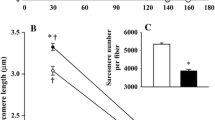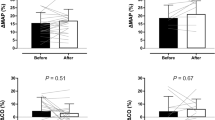Summary
Afferent nerve fibers from receptors situated in the interstitium of skeletal muscles can induce cardiovascular reflexes. It has been shown that these interstitial muscle receptors are also sensitive to the local state of hydration: increased heart rates and blood pressure values were seen during dynamic and static exercise after local dehydration on earth. Since weightlessness leads to a persisting fluid loss in the lower part of the body, we hypothesized that leg exercise in space would augment heart rate and blood pressure responses to a similar extent as during local, interstitial dehydration on earth. Initial measurements during weightlessness were obtained in one subject after 6 days of space flight. Heart rate and blood pressure responses to light static foot plantar flexion (18% of maximal voluntary contraction) were recorded in two sessions. To eliminate the influence of muscle perfusion, exercise was performed during a period of arterial occlusion obtained by means of pneumatic cuffs at mid-thigh level. Identical protocols were used in the pre- and postflight controls, which were performed both in the sitting posture and in a −90° tilted sitting posture assumed 30–40 min before arterial occlusion. During weightlessness the exercise responses of heart rate and systolic and diastolic blood pressure closely followed the tracings obtained with the tilted sitting posture on ground. The response amplitudes in these states of reduced lower limb volumes (about 20/min and 20 mmHg, respectively) exceeded the responses in the supine position by a factor of at least 2. Enhancement of cardiovascular reflexes following local fluid losses of skeletal muscles appears to be a general phenomenon that can also be seen during weightlessness.
Similar content being viewed by others
Abbreviations
- EMG:
-
Electromyogram
- LBNP:
-
Lower body negative pressure
- MVC:
-
Maximal voluntary contraction
References
Aukland K, Nicolaysen G (1981) Interstitial fluid volume: local regulatory mechanisms. Physiol Rev 61:556–643
Baisch F (1992) Orthostatic stress by lower body negative pressure and its body fluid distribution kinetic under μ-g. Clin Investig 71:690–699
Baum K, Essfeld D, Stegemann J (1988) The influence of muscle interstitial volume on K+-induced heart rate drive in rats. Eur J Appl Physiol 57:33–38
Baum K, Essfeld D, Stegemann J (1990) Reduction in extracellular muscle volume increases heart rate and blood pressure response to isometric exercise. Eur J Appl Physiol 60:217–221
Barrett TW (1975) Hyaluronic acid salt — a mechanoelectrical transducer. Biochim Biophys Acta 385:157–161
Bing RF, Smith AJ (1981) Plasma and interstitial volumes in essential hypertension: relationship to blood pressure. Clin Sci 61:287–293
Blomqvist CG, Stone HL (1983) Cardiovascular adjustments to gravitational stress. In: Shepherd JT, Abboud FU, Geiger SR (eds) Handbook of physiology, sect 2. The cardiovascular system, vol III, part 2. American Physiological Society, Bethesda, pp 1025–1063
Comper WD (1977) Electric potentials generated by connective tissue polysaccharides in glass capillaries. Biochim Biophys Acta 497:816–819
Essfeld D, Baum K, Stegemann J (1988) Local fluid losses enhance heart rate drives in light to moderate exercise. Aviat Space Environ Med 59:1055–1060
Flade K-D, Ewald R (1993) MIR '92: a joint Russian-German space mission. Clin Investig 71:675–677
Gauer OH, Thron HL (1965) Postural changes in the circulation. In: Hamilton WF, Dow P (eds) Handbook of physiology, sect 2. Circulation, vol III. American Physiological Society, Washington, pp 2409–2439
Hinghofer-Szalkay H (1980) Untersuchungen zum Einfluß von Körperlänge und Schwerelosigkeit auf die Eigenschaften von Blut und Blutplasma. Klin Wochenschr 58:1147–1154
Kirsch K, Merke J, Hinghofer-Szalkay H (1980) Fluid volume distribution within superficial shell tissues along body axis during changes of body posture in man. Pflügers Arch 383:195–201
Mitchell JH, Schmidt RF (1983) Cardiovascular reflex control by afferent fibers from skeletal muscle receptors. In: Shepherd JT, Abboud FU, Geiger SR (eds) Handbook of physiology, sect 2. The cardiovascular system, vol III, part 2. American Physiological Society, Bethesda, pp 623–658
Parent L, Caille JP (1985) Fixed charges of the heart muscle interstitium. Biophys J 47:725–729
Schütze H, Hildebrandt W, Stegemann J (1991) The interstitial fluid content in working muscle modifies the cardiovascular response to exercise. Eur J Appl Physiol 62:332–336
Author information
Authors and Affiliations
Rights and permissions
About this article
Cite this article
Essfeld, D., Baum, K., Hoffmann, U. et al. Effects of microgravity on interstitial muscle receptors affecting heart rate and blood pressure during static exercise. Clin Investig 71, 704–709 (1993). https://doi.org/10.1007/BF00209724
Revised:
Accepted:
Issue Date:
DOI: https://doi.org/10.1007/BF00209724




